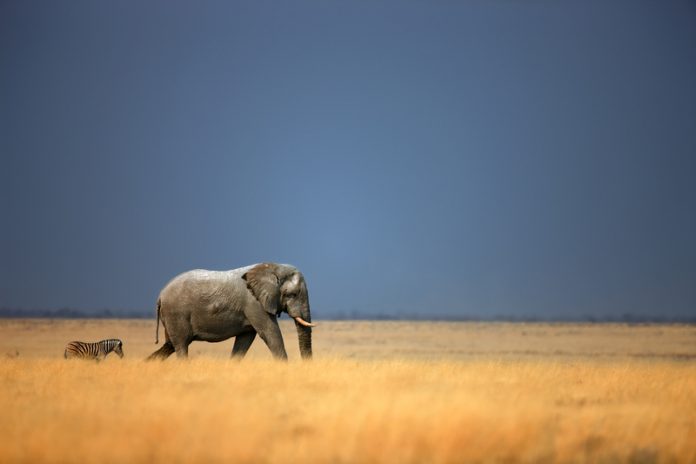The battle to save Africa’s most threatened wildlife species even as the continent develops, is the view put forward here by CEO of African Wildlife Foundation, Kaddu Sebunya
Africa is endowed with many wildlife species that occur in its various biomes and habitats. This rich diversity is Africa’s heritage; the very substrate that will drive the continent’s sustainable development. How Africa chooses to treat its natural environment (therefore, its people), will determine its development at all levels – local, national and continental.
Africa is already developing rapidly, boasting of megabucks infrastructure projects and some of the fastest growing economies in the world. The continent does not need to make a choice between conservation and development; the decision it needs to make is how to conserve natural resources and develop sustainably without taking away from the rights of future generations to enjoy wildlife in its natural habitat.
As CEO of the African Wildlife Foundation (AWF), I believe that the wildlife and wild lands of Africa will thrive in modern Africa. My optimism is backed by reality on the ground. First, we have to acknowledge the problem; over the last 60 years all but a few of Africa’s wildlife species have been steadily declining, and some have become extinct. But Africa is not alone in losing species. On a global scale, humanity is reported to have wiped out 60% of animal populations since the 1970s with huge costs even as the world feeds its burgeoning human population.
In the 1960s, most African countries earned their political independence and with it the custodianship over natural resources including wildlife. The results have been a mixed bag. Africa currently has an estimated 5,000 black rhino of the 65,000 in the 1960s, 415,000 of 1.2 million elephants and 20,000 of 200,000 lions. Even Africa’s tallest animal, the giraffe, has not been spared.
We have a good understanding of why our wildlife is declining – from habitat loss to illegal killings – we know enough to act. According to the latest statistics, the proportion of illegally killed elephants (PIKE) has remained at about 50% since 2002, rising to its highest in 2011 (75%) then declining to this day due to concerted conservation action. Rhinos, on the other hand, disproportionately die as a result of poaching.
Our aim must be to recover the declining species populations and to maintain those that are thriving in their natural environments, therefore, ensuring that these animals continue to rightfully contribute to Africa’s sustainable development and the wellbeing of her people.
Conservation interventions must first of all be data-driven and evidence-based. Adaptive management, for instance, which designs projects in such a way that mistakes are corrected as they occur, is a feedback-driven model that ensures conservation efforts are dynamic and change according to the needs of the landscapes on which they are deployed.
Secondly, work in African wildlife conservation over the last five decades shows that local community involvement is crucial for success and that at this level too, we must not equate development to the destruction of nature. Involving communities means good governance of natural resources and augurs well with any science-led innovative approach.
If you reduce the cost of living with animals, you turn local communities into conservation participants. Those of us who work in this field need to remember that Africans take pride in their wildlife and have been living with it since the dawn of time. Community knowledge about animal behaviour and habitat protection, therefore, is invaluable towards designing interventions.
Not only should conservation aim to reduce human-wildlife conflicts, but it should also provide a means of livelihood through several revenue streams. Aside from tourism, other sources of income include commercialisation of non-timber forest products, beekeeping, sustainable fishing and fodder production.
Using a combination of these approaches, AWF has managed to turn around the declining wildlife population in several landscapes across the continent. For instance, AWF funding has supported 14 elephant populations across nine African countries with an estimated cumulative population size of almost 190,000 individual elephants. Ten of these populations are stable or increasing. AWF has also supported 10 rhino populations across six African countries with an estimated cumulative population size of over 4,600 individual rhinos. All are stable or increasing.
Less appreciated by conservationists and others alike are the crucial roles played by wildlife species, wildlands and natural ecosystems in the wider development agenda. Without healthy natural ecosystems, Africa will be unable to provide food, water security and nutrition for its people. How will that be possible without the insects, and bats that pollinate our crops and trees? Africa’s wildlife and wild lands hold great potential as undiscovered biodiversity banks; as an insurance policy and risk mitigation for future needs.
It is key to integrate the science and the practice at all stages of conservation and development – in our planning, prioritisation, implementation, reporting and communication. This effort cannot be left to conservationists only. African leaders must rise to the challenge and include Africa’s wildlife and wildlands in their development agenda; young people must step up and take space as active participants in conservation at the highest levels – they are not the leaders of tomorrow, but the leaders of today; development partners must ensure that their involvement and investments or aid addresses the connections between development and conservation. This must be the African voice.
Kaddu Sebunya
CEO
African Wildlife Foundation
Tel: + 254 (0) 711 063 000











